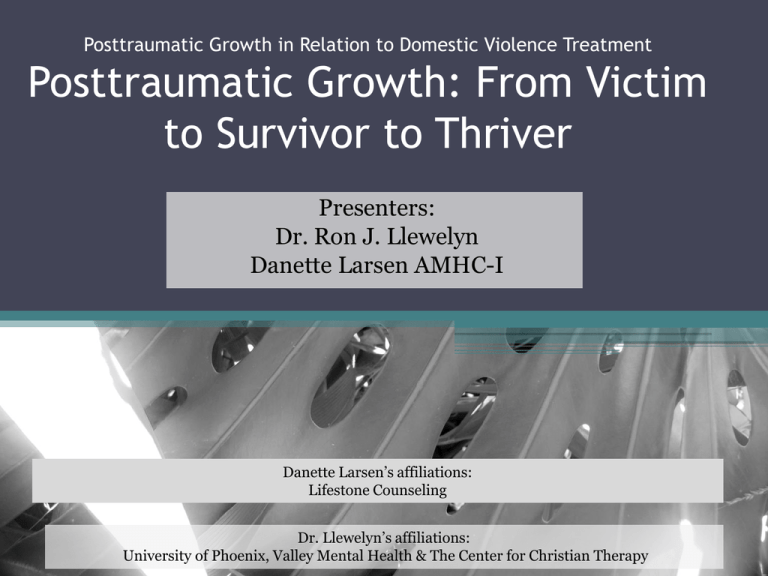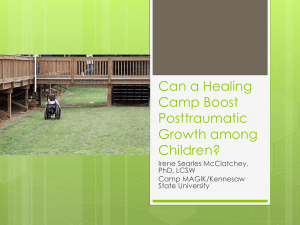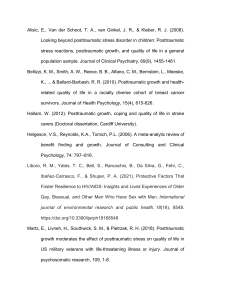Posttraumatic Growth: From Victim to Survivor to Thriver
advertisement

Posttraumatic Growth in Relation to Domestic Violence Treatment Posttraumatic Growth: From Victim to Survivor to Thriver Presenters: Dr. Ron J. Llewelyn Danette Larsen AMHC-I Danette Larsen’s affiliations: Lifestone Counseling Dr. Llewelyn’s affiliations: University of Phoenix, Valley Mental Health & The Center for Christian Therapy Objectives Learn about the theory, research and utilization of Posttraumatic Growth in our everyday and therapeutic interactions with offenders and survivors. Be able to identify the obstacles that limit a person’s ability to become a thriving individual. Walk away with specific methods to help those effected by domestic abuse The Corrective Therapeutic Experience Is Everyone A Therapist? Domestic Abuse Domestic Abuse As used in this chapter: (1) "Cohabitant" has the same meaning as in Section 78B-7-102. (2) "Department" means the Department of Public Safety. (3) "Divorced" means an individual who has obtained a divorce under Title 30, Chapter 3, Divorce. (4) "Domestic violence" means any criminal offense involving violence or physical harm or threat of violence or physical harm, or any attempt, conspiracy, or solicitation to commit a criminal offense involving violence or physical harm, when committed by one cohabitant against another. "Domestic violence" also means commission or attempt to commit, any of the following offenses by one cohabitant against another: (a) aggravated assault, as described in Section 76-5-103; (b) assault, as described in Section 76-5-102; (c) criminal homicide, as described in Section 76-5-201; (d) harassment, as described in Section 76-5-106; (e) electronic communication harassment, as described in Section 76-9-201; (f) kidnapping, child kidnapping, or aggravated kidnapping, as described in Sections 76-5-301, 76-5-301.1, and 76-5-302; (g) mayhem, as described in Section 76-5-105; (h) sexual offenses, as described in Title 76, Chapter 5, Part 4, Sexual Offenses, and Section 76-5b-201, Sexual Exploitation of a Minor; (i) stalking, as described in Section 76-5-106.5; (j) unlawful detention or unlawful detention of a minor, as described in Section 76-5-304; (k) violation of a protective order or ex parte protective order, as described in Section 76-5-108; (l) any offense against property described in Title 76, Chapter 6, Part 1, Property Destruction, Part 2, Burglary and Criminal Trespass, or Part 3, Robbery; (m) possession of a deadly weapon with intent to assault, as described in Section 76-10-507; (n) discharge of a firearm from a vehicle, near a highway, or in the direction of any person, building, or vehicle, as described in Section 76-10-508; (o) disorderly conduct, as defined in Section 76-9-102, if a conviction of disorderly conduct is the result of a plea agreement in which the defendant was originally charged with any of the domestic violence offenses otherwise described in this Subsection (4). Conviction of disorderly conduct as a domestic violence offense, in the manner described in this Subsection (4)(o), does not constitute a misdemeanor crime of domestic violence under 18 U.S.C. Section 921, and is exempt from the provisions of the federal Firearms Act, 18 U.S.C. Section 921 et seq.; or (p) child abuse as described in Section 76-5-109.1. (5) "Jail release agreement" means a written agreement: (a) specifying and limiting the contact a person arrested for a domestic violence offense may have with an alleged victim or other specified individuals; and (b) specifying other conditions of release from jail as required in Subsection 77-36-2.5 (2). (6) "Jail release court order" means a written court order: (a) specifying and limiting the contact a person arrested for a domestic violence offense may have with an alleged victim or other specified individuals; and (b) specifying other conditions of release from jail as required in Subsection 77-36-2.5(2). (7) "Marital status" means married and living together, divorced, separated, or not married. (8) "Married and living together" means a man and a woman whose marriage was solemnized under Section 30-1-4 or 30-1-6 and who are living in the same residence. (9) "Not married" means any living arrangement other than married and living together, divorced, or separated. (10) "Pretrial protective order" means a written order: (a) specifying and limiting the contact a person who has been charged with a domestic violence offense may have with an alleged victim or other specified individuals; and (b) specifying other conditions of release pursuant to Subsection 77-36-2.5(3)(c), Subsection 77-36-2.6(3), or Section 77-36-2.7, pending trial in the criminal case. (11) "Sentencing protective order" means a written order of the court as part of sentencing in a domestic violence case that limits the contact a person who has been convicted of a domestic violence offense may have with a victim or other specified individuals pursuant to Sections 77-36-5 and 77-36-5.1. (12) "Separated" means a man and a woman who have had their marriage solemnized under Section 30-1-4 or 30-1-6 and who are not living in the same residence. (13) "Victim" means a cohabitant who has been subjected to domestic violence. Amended by Chapter 39, 2012 General Session http://le.utah.gov/code/TITLE77/77_36.pdf How do we screen for domestic abuse? Domestic Abuse & PTSD II Psychological Trauma: The sudden uncontrollable disruption of our affiliative bonds. Lindemann 1944 Domestic Abuse & Complex PTSD • Perception of self starts to change ▫ ▫ ▫ ▫ ▫ ▫ ▫ ▫ ▫ ▫ ▫ ▫ ▫ • • ▫ ▫ May rationalize their behavior to others May rational their behavior to self May blame self for their behavior Due to isolation, feels they are the only one there for them My become dependent upon them May perceive them with unrealistic power. Perception of Close others & the World ▫ ▫ ▫ • Complex PTSD Relational Idealization of the Offender ▫ ▫ ▫ ▫ • Lowered or lost confidence Questioning own decisions Questions if anyone loves them Blames self for others leaving Starts to feel defiled Starts to feel helpless Starts to feel hopeless Feels shame, guilt and blame Identifies with abuser language Believes that options are few Increase sense of insecurity Increase in emotional states Turning Against the Self Due to isolation, may feel abandoned Others will not understand May see others as a threat People have failed to rescue them Self Repeated Trama Offender Others Meaning Physical-CognitiveEmotional Somatic Flashbacks Dissociation Affective Dysregulation Destruction of the Assumptive World Janoff-Bulman Epstein We are not vulnerable The World is a Source of Joy The World is Predictable & Controllable The World is Controllable We Merit Self Worth I am Competent & Good I Feel Crazy Strength Based/Wellness Enhancement Posttraumatic Growth What Is Posttraumatic Growth? History of Posttraumatic Growth Ancient texts Strens (Hollister 1965) Salutogenesis (Antonovsky 1979) Resilience Thriving (O’Leary & Ickovics, 1995) The Role of Rumination A cognitive processing model Attempts to understand Attempts to create meaning Counter-arguments PTG not well operationalized Simply a coping strategy Simply Positive Illusions Posttraumatic Growth Research Findings Resiliency Factors Individual *Familial Macro • • • • • • Nurturing • Stable Home • *Other support • Pro-social organizations Temperament *Intellect *Self worth ILOC Self-efficacy * Most often reported Areas of Posttraumatic Growth Outcomes Grubaugh & Resick, 2007 Improved self efficacy Change in how one relates to others Increased Spirituality Aware of New Possibilities Greater Appreciation for Life Posttraumatic Growth Research Findings (Limitations) Operationalization Measurement Posttraumatic Growth Research Findings PTSD PTG • PTG does not = reduced PTSD • Higher PTSD=Higher PTG • • • • Higher amongst the spiritual Higher amongst the supported Higher with age Does not reduce re-victimization Our Role in Posttraumatic Growth The Role of Disequilibrium Primary Premise “…the reconstruction of in “…This process is anchored meaning is necessary the meaning that one because trauma works by attributes to the traumatic threatening or dismantling incident as well as in how one the individuals view of the viewsself oneself andworld.” the world.” and the (Cadell, Regehr & Hemsworth, 2003) Porchaska Precontemplation Preparation Resiliency Contemplation Action Assessing for Strength Based Competencies “…the measurement of those emotional and behavioral skills, competencies, and characteristics that create a sense of personal accomplishment; contribute to satisfying relationships with family members, peers, and adults; enhance one’s ability to deal with adversity and stress; and promote one’s personal, social, and academic development.” (Epstein & Sharma, 1998) Assessment Assess for resiliency factors Assess for previous successes Assess for current attitude Tedeschi and Kilmer 2005 • • • • • Listen for evidences of strengths Interests Hopes Give examples of previous struggles Give examples of what you are good at and what makes you proud (do they struggle with this, initial response of the helper is to jump in and help, which takes away their struggle to find something). • “What does that mean about you?” Strength Based Assessments • What do you want to accomplish in your life? • What personal qualities are helping you move forward in this direction? • When people say good things about you, what are they likely to say. • How would you know if things were going good in your life? What brings genuine pleasure. • How have you managed to overcome the challenges you faced (give example). • What have you learned about yourself and your world during your struggles. (University of Wisconsin). • Which of these difficulties have given you special strength, insight, or skills? • Who are you? (is this their own identity or the product of negative introjections) • Describe yourself (again negative introjective processes). Corrective Therapeutic Experiences: An In Depth Look at Safety, Trust & Boundaries The Person in Context “…a multifaceted approach to intervention is advocated: targeting multiple potential risk or protective influences rather than one or two in isolation greatly increases the likelihood of positive outcomes.” Stage one: Stabilization Primarily a personal experience Education Physical Well Being Self Soothing Primarily a social experience Boundaries Safety & Safety Planning Trust The Neurobiology of the Fight or Flight Response Stressful Event Thalamus This occurs before information reaches the Cortex Cortex Amygdala Locus Coeruleus Hypothalamus Sympathetic NS Pituitary Adrenal Medulla Thyroid Thyroxin Adrenal Cortex Cortisol Adrenaline Noradrenalin Adapted from Preston, O’Neal, & Talaga 2010 Neuro-anatomical Factors Stage One: Self Soothing Breathing Exercise/Activity Clients discover and adopt healthier ways of coping with stressors. Guided imagery Journaling/Writing Art Music Nature Stage One: Psychosocial Redevelopment (Herman, 1992) Stage One: Safety, Trust & Boundaries Trust vs. Mistrust/Oral Autonomy vs. Shame & Doubt The Paradox of Growth Growth and vulnerability go hand in hand. Developmental Models Trust vs. Mistrust Autonomy vs. Shame & Doubt Oral Anal Hope Willpower Purpose Initiative vs. Guilt Industry vs. Inferiority Genital Competence Latency Fidelity Identity vs. Role Confusion Intimacy vs. Isolation Love Phallic Generativity vs. Stagnation Care Integrity vs. Despair Wisdom Homeostatic Mechanism of Attachment “The attachment system acts as a kind of homeostatic mechanism for modulating anxiety and stress by seeking out an attachment figure for security and protection.” (Bowlby, 1978) Janssen, C. G. C., Schuengel, C., & Stolk, J. (2002). Understanding challenging behaviour in people with severe and profound intellectual disability: A stress-attachment model. Journal of Intellectual Disability Research, 46, 445-453. Enhancing Posttraumatic Growth through the Corrective Therapeutic Experience Repetition Compulsion “The patient cannot remember the whole of what is repressed in him, and what he cannot remember may be precisely the essential part of it…He is obliged to repeat the repressed material as a contemporary experience instead of remembering it as something in the past.” • Sigmund Freud Trust Vs. Mistrust (Hope) First World Ontogenesis of Hope Delay of Gratification/Abandonment Trust vs. Mistrust Autonomy vs Shame & Doubt Passing the test… Transference The Stance Transference Testing Neutral Passive to Active Transformation Disinterested Repetition Compulsion: Transference Testing Transference Testing •Will you do it? Passive To Active Transformation •Can you handle it? How To… Exposure to others in different stages of Posttraumatic Growth as a model. Transference… Focus on strengths in all areas of life. We control the temperature… Autonomy vs. Shame & Doubt (Will Power) Self Control without loss of self-esteem Compulsive compliance or impulsive defiance Will Power Autonomy vs. Shame & Doubt Initiative vs. Guilt The Transference Neurosis An Omnipotent Rescuer An Unpredictable Abuser Our desire to save Our agenda Our Own Issues Inability to sit with client Our projections Or reenactments Overly rigid boundary response Overly Permeable boundary response We Should… Herman (1997) pg. 135 Remain “Disinterested” Remain “Neutral” How can you tell? Over engaged with or Doa guest you find client? yourself…? Rebuilding the Assumptive World • Recognizing the worth of each individual • Helping (not forcing) envision a future full of promise and potential • Actively empowering guest in their care • Celebrate changes to each persons’ sense of self • Turner, S. & Cox, H (2004) Facilitating post traumatic growth. Health and Quality of Life Outcomes, 2 (34). Initiative vs. Guilt (Purpose) Development of Superego Development of Roles Finding Purpose & Self Initiative Initiative vs. guilt Industry vs. Inferiority Industry vs. Inferiority (Competence) Take School & Cultural Role Development of inadequacy Competence Industry vs. Inferiority Identity vs. Identity Confusion Identity & Repudiation vs. Identity Confusion (Fidelity) Impulse Vs. Compulsive Restraint Self-Definition Fidelity Identity vs. Identity Confusion Intimacy vs. Isolation Intimacy & Solidarity vs. Isolation (Love) Self Abandonment “Way of Life” The Defensive Wall Intimacy vs. Isolation Generativity vs. Self Absorption Generativity vs. Self-absorption/Stagnation (Care) Dependency & Maturity are Reciprocal Guiding the Next Generation Relation to Stage 3 Generativity vs. Self Absorption Integrity vs. Despair Integrity vs. Despair (Wisdom) Integrity of experience Letting go Sign of conflict is doctoring of memories Generativity vs. Self Absorption Thank You for Your Attendance For further information contact Dr. Ron J. Llewelyn at ron@centerforchristiantherapy.com Download PowerPoint and Handouts at www.livingwaterscounselingllc.com








